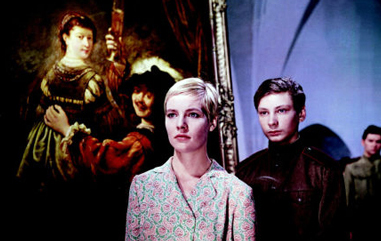
 |
|
|
|
Every few weeks we read news of famous artwork treasures being stolen or recovered, or of a gallery or museum being sued with demands to return items purloined from other collections. Big museums must deal with diplomatic hostility over fabled artworks taken centuries ago by conquerors like Napoleon Bonaparte. Bitter lawsuits and demands are still coming to light over artworks that were 'redistributed' in WW2. The Germans had time to strip the territories they occupied of everything not nailed down. This year's The Monuments Men dramatizes the work of Allied commandos to save artworks from destruction by the retreating Germans. 
After being all but obliterated by U.S. bombing, Dresden has fallen to the Russian Army. Commando Captain Leonow (Wsewolod Safonow) and his squad finds German artist Paul Naumann (Heinz-Dieter Knaup) still painting in a ruined cellar, and is impressed. Paul's work concentrates on his lost love Katrin, a communist. Leonow enlists Paul to help find where the Germans have hidden the contents of Dresden's Old Masters Gallery. Russian General (Michael Majorow), is just as committed to preserving culture; he renews his friendship with German communist Erich Braun (Wilhelm Hoch-Hooge) as they fought fascism together in Barcelona ten years before. The museum's librarian Luise Rank (Marga Legal) provides mysterious maps that help the team locate caches of paintings hidden in a railroad tunnel, a disused mine shaft and Waldheim Castle, which Leonow's men must wrest from a maniacal SS holdout. Russian art
This East German/Russian co-production has three directors. Supervisor Lev Arnshtam worked with two German and Russian sub-directors, that most likely divided their work along language lines. The drama is the expected story of enemies becoming friends, thanks to the humanist values of the Russian liberators. The handsome captain bears the defeated Germans with nothing but good will, overcoming their fear and distrust. The earthy, noble Sgt. Koslow lets little German tykes play with his mustache. He sees the image of his slain family as he stares reverently at the paintings. Muscovite art restorer Nikitina, apparently now officially in the services, has difficulty with her army boots. The General and
Director Lev Arnshtam shoots the film in a non-fussy but efficient manner. The adventures take the Trophy Commandos and their new German friends across the countryside, taking breaks to show the benevolent Russian Army is helping the downtrodden Germans. Every few minutes we get a short debate or lecture on the righteousness of the mission and the higher motives of the Russian liberators. There is not a hint of the horror stories of the Russian advance heard in the West -- rape and slaughter before, mass arrests & deportations after -- in retribution for the millions of Russian civilians murdered by the Germans. In this 'we're all friends' version of history, only the fiendish SS and their werewolf holdouts are to be blamed -- although several German characters express regret their passive part in Nazi evil.
According to the movie's version of events, the Soviet liberators are the saviors of German art. Ordinary Russian
soldiers recognize and worship the paintings that are found. A beautiful color montage of paintings is accompanied by
The essays included with this impressive disc presentation tell a different story. In reality, Stalin methodically looted classic art and artifacts from Germany. Thousands of individual paintings were simply loaded into trains and whisked away to Moscow, so much that ten years later a great deal of it had still not been inventoried. Most of the art had been carefully stored by German curators, and was found in good condition. Private looting also took place, on a grand scale. The Germans had a name for it: Beutefieber (plunder fever). The victorious General Zhukov ended up with a country home packed with stolen antiques and museum-worthy art, outside of the official program that filled Stalin's coffers. As is usual, the paintings were considered the rightful spoils of war, 'seized on account' as part of German reparations. A big publicity/propaganda deal in 1955 saw a few trainloads of artwork returned to East Germany, a tiny fraction of what had been taken.
The movie expends all of its energy to argue for better German-Soviet relations. There is no anti-West rhetoric. No mention is made of the controversy surrounding the joint British-American bombing raids on the city. The movie's opening
Good-looking Captain Leonow is practically a ray of sunshine; he reminds us a bit of New Zealand actor Sam Neill. Paul Naumann is acceptable as a soulful but disillusioned artist. The actress playing the lost/recovered Katrin seems to have been picked for her looks. Their romantic story is marginalized in favor of their adjustment to the new society. She's not quite convincing as a 'great love' nor as a concentration camp survivor. All the German characters experience political epiphanies as they find a way to move forward in their lives. They've lost their loved ones but are welcomed into a non-traditional future in the new communist 'social family'. The Russians serve basically as social workers, to help Germans overcome those irrational anti-Soviet feelings. Russian Sgt. Koslow is just a big Teddy Bear and a lover of children, a new 'warm and fuzzy' image to replace the invading monster of the public imagination. 1 The DEFA Film Library's DVD of Five Days, Five Nightsis a good transfer from what looks like a very good print of this color production. The images posted here are close to the color values on view, but the disc is much sharper. The color process is not identified; it looks passable even if this transfer doesn't bring out fine distinctions in hues. Scenes of the Russians in Dresden are filmed on a broad scale, with plenty of Soviet military hardware and hundreds of displaced camp inmates marching on the roads. We're told that much of Dresden was still in bad shape in 1960, yet 'new' rubble had to be positioned to film famous buildings at the cleaned-up city center. Some of the stage-constructed interiors have over-done painted wear and stains on walls. The art directors obviously didn't want to waste the opportunity of color film. 
The disc is an academic-quality teaching and research resource, with DVD-Rom files containing four expert essays. The authors are listed further below. Shostakovich and Arnshtam: Five Days, Five Nights covers the famous composer's career in film. He played accompaniments for silent movies and provided scores for the famed Maxim Trilogy as well as propaganda films about Stalin and a cinematic defense of the dreaded purges. Shostakovich's music for this movie is based on his 8th String Quartet. Stalin's Trophy Art: Before and After 1945, documents the river of looted art that flowed Eastward in 1945, much of it already stolen by the Germans. Over 2.5 million art objects were preserved 'for the masses.' The unofficial stuff hit the black market and sold for fortunes to collectors in the West. Many paintings are identified not only by their painters, but by their history as objects moved about from victor to victor. 
Rembrandt and Ruins: The Scenography of Art and Destruction examines the film's art direction by Herbert Nitzschke. Close-ups of masterpieces like Rembrandt's Self-Portrait with Saskia were filmed in museums, while expert copies were used elsewhere. Confessions of a Silent Madonna directly addresses the importance of one masterwork, the Sistine Madonna, which was part of the collection returned to Germany in 1955. The return of this particular religious painting drew attention away from Stalin's program to suppress Christian education and discourage religious worship in general.
On a scale of Excellent, Good, Fair, and Poor,
Five Days, Five Nights DVD
Footnotes:
1. The availabiity of Soviet-influenced movies invites comparisons with our own films. The benign Russian Sgt. Koslow is clearly formulated to counter the stereotype of the 'evil Cossack', and we have no difficulty labeling his 'kind to kids' scenes as purposely misleading, even cynical. Yet our own American combat movies frequently show soldiers in war zones befriending children, with the implied message that whereever Yankees soldiers go, they spread peace, security and harmony. Five Days' Sgt. Koslow and The Green Berets' John Wayne are each presented holding hands with an adorable tot, while voicing optimistic sentiments about the future: "Hey kid. You're what this war is all about!"

The version of this review on the Savant main site has additional images, footnotes and credits information, and may be updated and annotated with reader input and graphics.
Review Staff | About DVD Talk | Newsletter Subscribe | Join DVD Talk Forum |
| ||||||||||||||||||